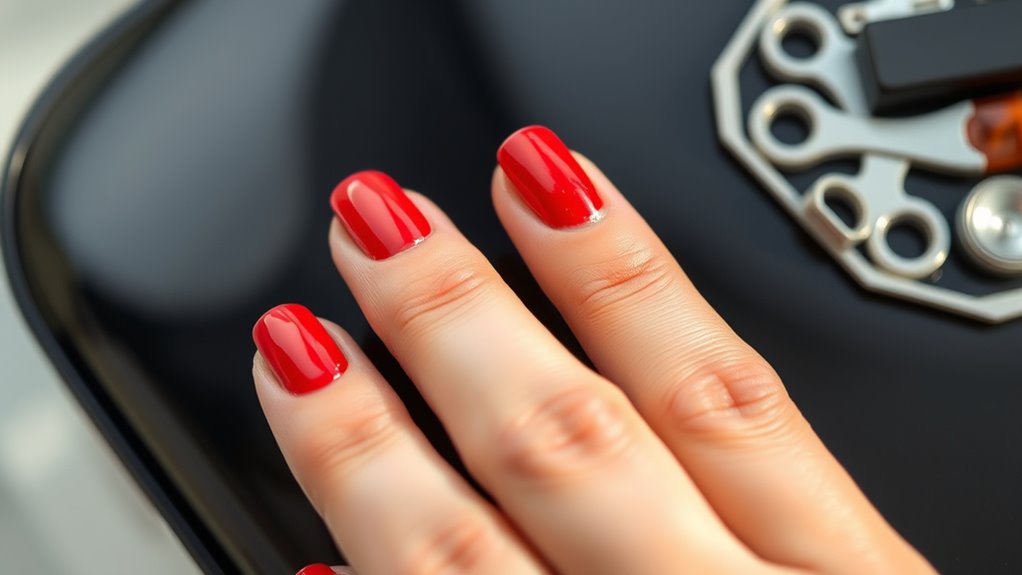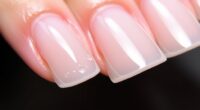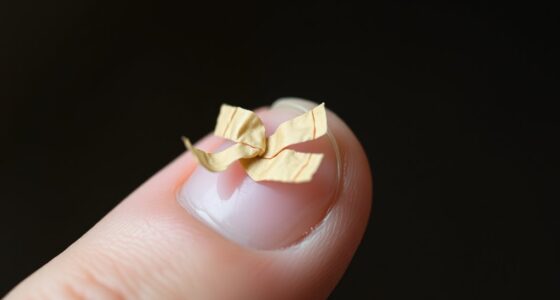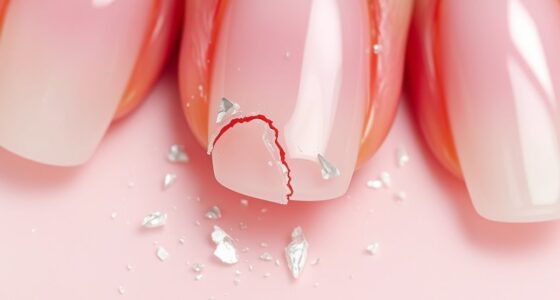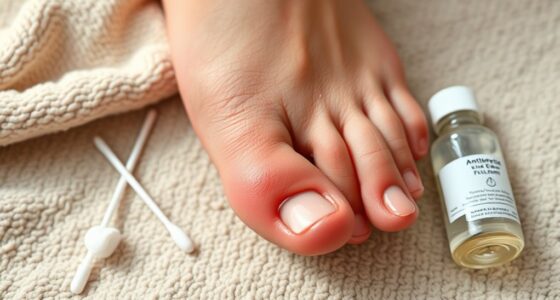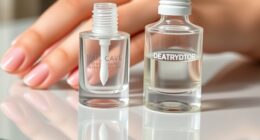To stop your polish from chipping, start by preparing your nails properly—clean, dry, and free of oils—then apply a base coat and let it dry completely. Use thin layers of polish, allowing each to dry fully before adding the next, and finish with a high-quality topcoat that seals in color and offers protection. Reapplying topcoat every few days keeps nails looking fresh. For quick fixes, repair chips immediately with polish plus a sealant. Keep tips in mind for long-lasting shine and durability.
Key Takeaways
- Always start with clean, oil-free nails and apply a good quality base coat for better adhesion.
- Use thin, even coats of polish and let each layer dry completely to prevent chipping.
- Seal the edges and tips of nails with topcoat for added durability and chip prevention.
- Reapply a clear topcoat every few days to maintain shine and protect against chips.
- Quickly fix chips by applying a small layer of polish and sealing with topcoat immediately.

Chipped polish can quickly ruin the perfect manicure, but you don’t have to accept it as inevitable. The key to a longer-lasting finish starts with proper nail prep. Before you even apply polish, verify your nails are clean, dry, and free from oils or residue. Use a gentle nail cleanser or alcohol wipe to remove any oils that could interfere with adhesion. Once your nails are prepped, file them into your desired shape, smoothing out any rough edges. This creates a solid surface for the polish to grip. Don’t skip a base coat, either. A good base helps the polish adhere better and prevents staining, especially if you’re using dark or vibrant shades. Applying a thin, even layer of base coat and letting it dry completely sets the foundation for a durable manicure.
When it comes to applying your color, use multiple thin coats rather than one thick layer. Thick coats take longer to dry and are more prone to smudging or chipping. After each coat, give it a few minutes to dry thoroughly before applying the next. This step ensures a smooth, even finish that’s less likely to chip prematurely. Once you’ve achieved your desired color intensity, the most essential step in preventing chips is topcoat application. A high-quality topcoat seals in the color and provides a protective layer that resists chipping and peeling. Be generous but careful when applying it—cover the entire nail, including the edges and tips, to create a sealed barrier. Don’t rush this step; a well-applied topcoat not only enhances shine but also extends the life of your manicure.
After your nails are fully dry, avoid activities that can cause immediate chips, like heavy typing or knocking objects against your nails. Keep your hands moisturized with cuticle oil and hand cream, but wait a few minutes after applying topcoat before doing so, as moisture can weaken the polish’s integrity. Good nail prep can significantly improve the longevity of your manicure and help prevent chipping. If you notice a chip forming, don’t panic. You can do quick fixes by applying a small amount of polish over the chipped area and sealing it with a fresh layer of topcoat. This simple touch-up can help extend the life of your manicure without having to start over.
Frequently Asked Questions
How Long Should I Wait Before Applying a Top Coat?
You should wait about 2-3 minutes after applying your base coat before adding a top coat. This drying time allows the base coat to set properly, which is essential because of its importance in preventing chipping. Use quick drying time tips like fan drying or thin layers to speed up the process. Rushing can cause smudges or uneven finish, so patience guarantees a longer-lasting, flawless manicure.
Can Diet Affect Nail Polish Durability?
Your diet impact can influence how long your nail polish lasts. Nutritional tips like eating foods rich in biotin, zinc, and keratin help strengthen your nails, making them less prone to chipping. When your nails are healthier, your polish stays intact longer. So, paying attention to your diet isn’t just good for your overall health but also enhances your manicure’s durability, keeping it looking fresh for days longer.
Are There Natural Remedies to Prevent Chipping?
You’re wondering if natural solutions can prevent chipping? Home remedies like applying coconut oil or vitamin E oil can strengthen your nails and protect your polish. Keep your nails moisturized to prevent dryness and cracking, which often cause chips. Using a base coat made from natural ingredients or applying a quick top coat can also extend your polish’s life. These natural solutions are simple, affordable, and effective for maintaining a chip-free manicure.
How Often Should I Remove and Reapply Polish?
Think of your nails as a delicate garden that needs care. You should remove and reapply polish every 5 to 7 days to maintain nail health and prevent chipping. Use gentle polish removal methods, like acetone-free remover, to avoid damage. Regular breaks from polish give your nails time to breathe, keeping them strong. By sticking to this schedule, you’ll keep your nails looking fresh and healthy.
Does Nail Shape Influence Polish Chipping?
Your nail shape can influence polish chipping, especially if you have nails with pronounced curvature. Curved nails may cause the polish to lift at the edges more easily, leading to chipping. To prevent this, focus on edge protection by applying thin layers and sealing the tips well. Choosing a shape with less extreme curvature can also help your polish stay intact longer, reducing the likelihood of chips.
Conclusion
Think of your nails as a delicate garden; with proper care, they flourish and stay vibrant. By following these simple tips—like applying a top coat, avoiding harsh chemicals, and giving your nails time to breathe—you’ll keep your polish looking fresh and chip-free. Remember, each small step is like watering your garden, nurturing your nails to stay beautiful longer. Keep up the effort, and you’ll enjoy a flawless manicure that blooms with confidence every time.
